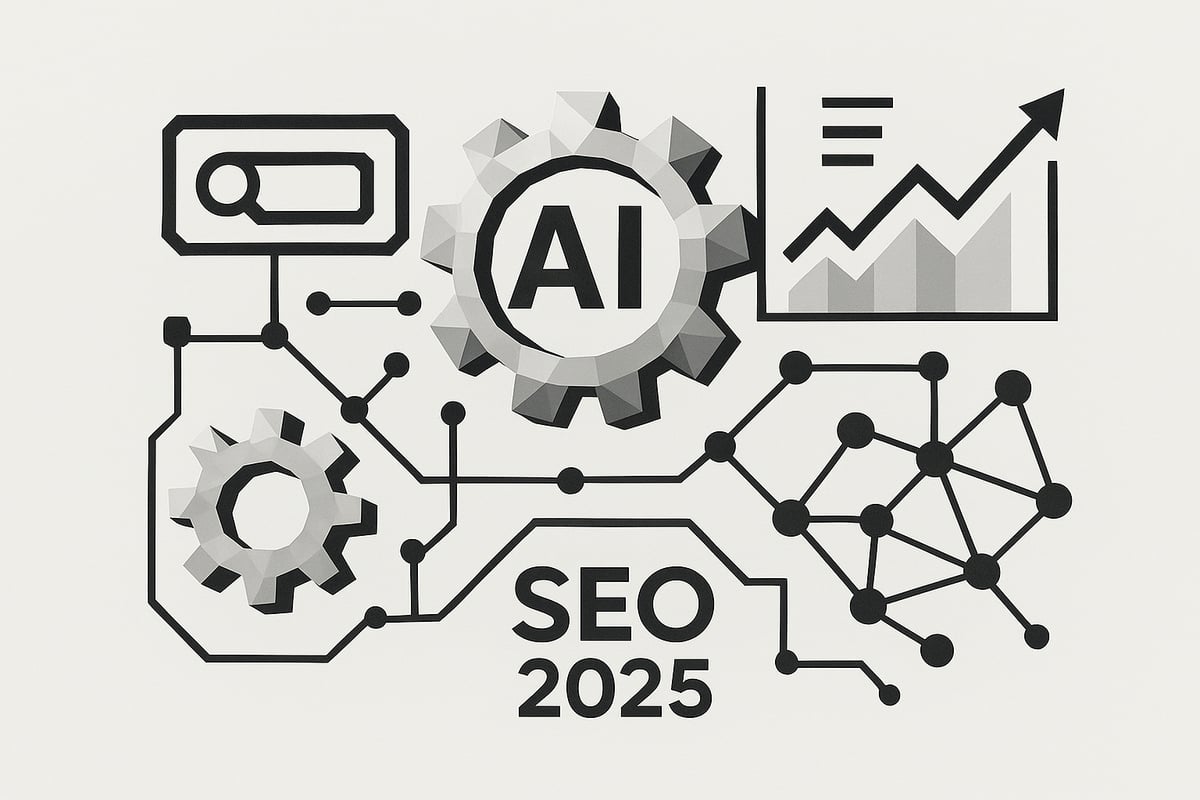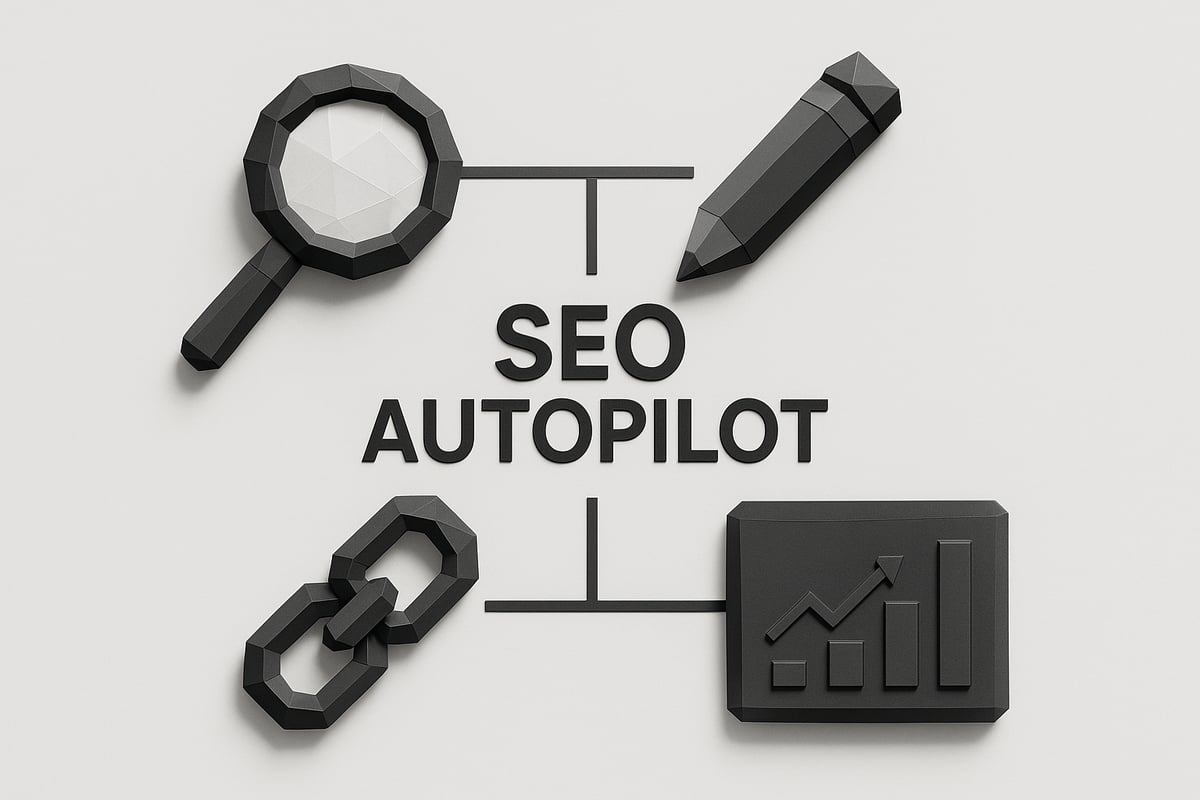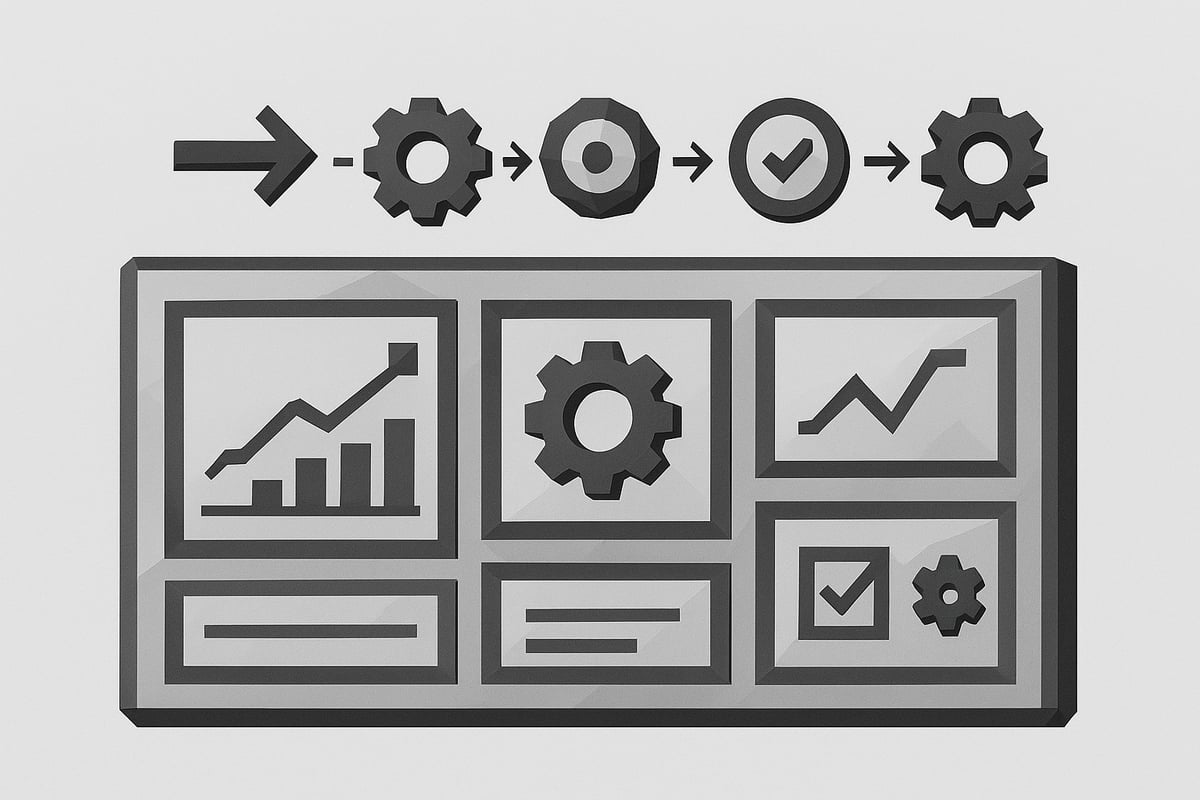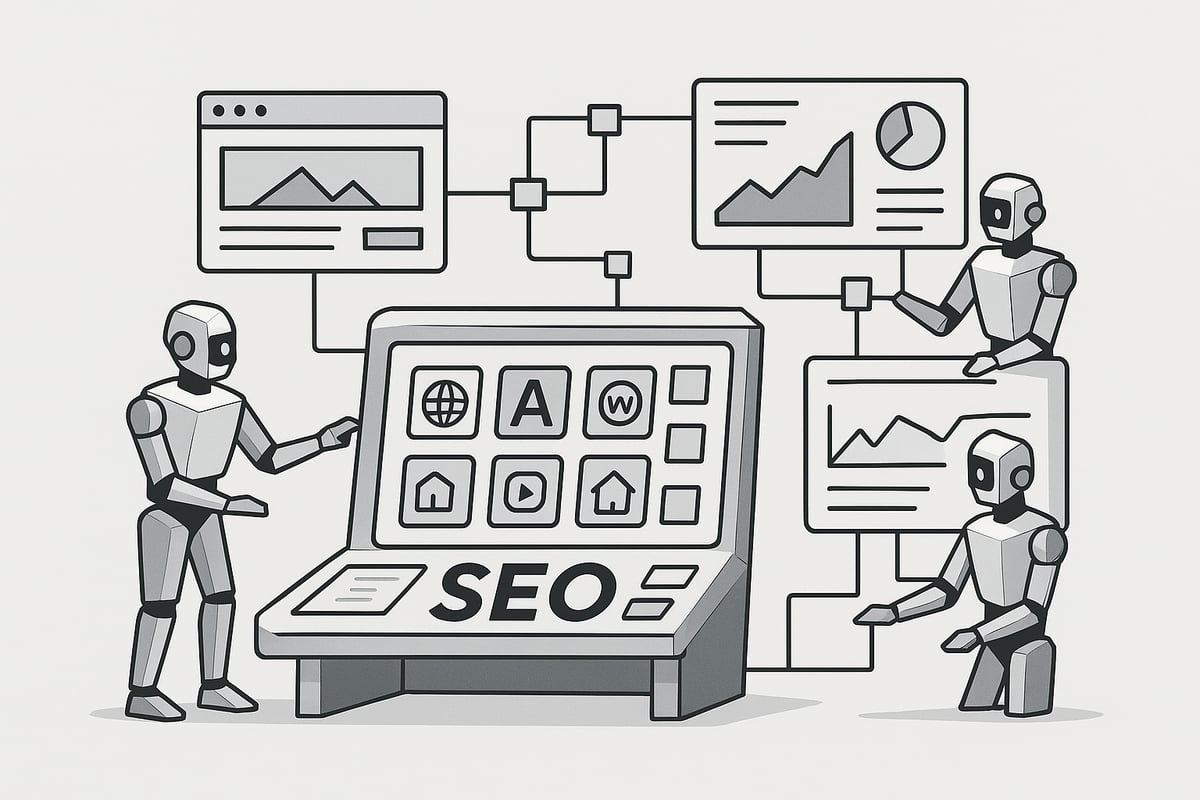The SEO world in 2025 is changing at lightning speed, with seo autopilot now essential for anyone aiming to stay ahead. Search algorithms have become more complex, and the sheer volume of available tools makes manual optimization nearly impossible for most businesses.
By mastering seo autopilot, you gain the power to save time, scale your website faster, and secure consistent high rankings in search results. This guide will show you, step by step, how to take full control of automated SEO in the year ahead.
You will discover the fundamentals of seo autopilot, essential tools and platforms, practical workflows, advanced automation strategies, and the future trends shaping tomorrow’s SEO landscape.
Understanding SEO Autopilot: Fundamentals and Evolution
Imagine managing hundreds of ranking factors, endless keyword lists, and a constantly shifting digital landscape. In 2025, this is the daily reality for SEO professionals. Manual optimization is no longer viable. This is where seo autopilot comes into play, making automation an essential part of staying ahead.
At its core, seo autopilot refers to the automation of repetitive SEO tasks such as keyword research, link building, content optimization, and performance reporting. What began as simple link-building scripts has evolved into sophisticated, AI-driven platforms that integrate seamlessly with your entire tech stack.
The evolution of seo autopilot has mirrored the complexity of Google’s algorithms. As search engines became more nuanced, automation tools grew smarter. Modern platforms now utilize artificial intelligence and machine learning to analyze vast datasets, predict ranking trends, and personalize optimization strategies in real time.
Why does seo autopilot matter so much in 2025? The answer lies in efficiency and scale. With the explosion of new tools and data, automated systems can process information faster and more accurately than any manual effort. They allow teams to focus on strategy while machines handle the heavy lifting.
Let’s break down the key benefits and potential pitfalls:
| Benefits of SEO Autopilot | Risks & Limitations |
|---|---|
| Massive time savings | Over-automation issues |
| Scalable workflows | Quality control challenges |
| Improved accuracy | Potential search penalties |
| Competitive advantage | Algorithm dependency |
Automation empowers agencies and solo SEOs alike. For example, agencies have shifted their workflows to dedicate more resources to creative strategy, relying on seo autopilot tools for day-to-day execution. Solo practitioners now scale their campaigns without needing large teams.
However, there are risks. Over-automation can lead to generic content or unnatural link profiles. Quality control and human oversight remain critical to avoid penalties from search engines.
Industry data highlights the momentum: According to recent reports, 61% of marketers automated at least part of their SEO process by 2024. This upward trend is expected to continue as the technology matures and adoption grows. For a deeper dive into the fundamentals and benefits of automated optimization, refer to this Automated SEO strategies overview.
In summary, seo autopilot is transforming the SEO landscape by making complex tasks manageable and scalable. Understanding its fundamentals and evolution is the first step toward mastering modern search optimization.

Core Components of an Effective SEO Autopilot System
In 2025, building a robust seo autopilot system means integrating automation at every stage of your SEO workflow. Each component plays a unique role in driving efficiency, accuracy, and sustainable results. Let’s break down these core elements and see how they collectively form a modern seo autopilot framework.

Automated Keyword Research and Competitor Analysis
Automated keyword research is the engine of any seo autopilot setup. Instead of manually sifting through keyword lists, AI-driven platforms surface high-value keywords and clusters based on live search trends and competitor movements. These systems track rankings, backlinks, and content gaps in real time, helping you uncover opportunities your competitors might miss.
For example, an agency using seo autopilot tools can identify long-tail keywords and content clusters with a few clicks. Studies show automated keyword research saves up to 70% of the time compared to manual processes.
A quick comparison table:
| Task | Manual Effort | SEO Autopilot Time |
|---|---|---|
| Keyword Discovery | High | Low |
| Competitor Tracking | High | Low |
| Opportunity Analysis | Medium | Low |
To explore top platforms for these tasks, check out this Best SEO automation tools guide.
Content Creation and Optimization Automation
Content is at the heart of every seo autopilot system. Modern automation tools can generate blog posts, product pages, and even metadata at scale. AI ensures each piece aligns with search intent and reads naturally, while also optimizing for readability and engagement.
Platforms now provide features like auto internal linking and multimedia integration. You can set up daily, optimized content publication schedules, freeing your team to focus on strategy.
With seo autopilot, it becomes possible to deliver consistent, high-quality content that adapts to changing algorithms. Automation here means your site remains fresh and relevant with minimal manual input.
Backlink Building and Authority Management
Building authority is critical, and seo autopilot systems now automate much of the outreach process. These platforms can handle guest posting, profile link creation, and even anchor text management with precision.
Campaign wizards and diagram editors let you visualize and scale your backlink strategies. By automating link diversity and quality checks, you reduce the risk of penalties and maintain a healthy link profile.
For instance, agencies use seo autopilot tools to run campaigns that build backlinks steadily over time, adapting to Google’s evolving guidelines. This ensures safe, effective authority growth.
Reporting and Performance Tracking
Effective seo autopilot setups include automated reporting and analytics. Rank tracking, traffic analysis, and performance dashboards update in real time, giving you immediate insight into what’s working.
White-label reporting allows agencies and consultants to share live data with clients without manual effort. Exportable reports and automated alerts for ranking drops or traffic spikes keep your team proactive.
By integrating reporting into your seo autopilot system, you ensure continuous optimization and clear visibility into ROI. This transparency is vital for both in-house teams and agencies managing multiple projects.
Step-by-Step Guide: Implementing SEO Autopilot in 2025
Embarking on the journey to implement seo autopilot in 2025 requires a strategic, stepwise approach. By breaking the process into clear actions, you can streamline your workflow, reduce manual labor, and position your website for sustained organic growth.

Step 1: Setting Your SEO Goals and KPIs
Every successful seo autopilot strategy starts with clear, measurable objectives. Begin by identifying your target keywords, key landing pages, and the specific outcomes you want to achieve. Are you aiming for higher rankings in local search, increased e-commerce sales, or broader brand visibility?
Define your KPIs to guide your automation. Common metrics include:
- Organic traffic growth
- Conversion rate from organic search
- Number of keywords ranking in the top 3 positions
- Backlink acquisition rates
- Bounce rate and average session duration
Align your seo autopilot setup with business objectives. For example, a local service provider might focus on Google Maps rankings and review generation, while an online retailer prioritizes product page visibility. Establish automated goal tracking to monitor progress and adjust your strategy as needed.
Step 2: Selecting the Right SEO Autopilot Tools and Platforms
Choosing the right technology stack is crucial for effective seo autopilot implementation. Evaluate platforms based on integration capabilities, scalability, and customer support. Look for tools that offer real-time data analysis, AI-driven insights, and broad compatibility with your existing systems.
A quick comparison of leading features:
| Platform Feature | Importance | Example Tools |
|---|---|---|
| AI Keyword Research | High | SEMrush, Ahrefs |
| Automated Reporting | Essential | AgencyAnalytics, RankPill |
| Content Automation | Critical for scale | Surfer, Jasper, RankPill |
| Backlink Management | Must-have | Pitchbox, RankPill |
| API Integrations | Enables customization | Zapier, Integromat |
Prioritize solutions that centralize your seo autopilot processes. Review pros and cons, such as ease of setup, pricing, and update frequency. A well-chosen stack will enable rapid scaling and consistent results.
Step 3: Configuring Automated Keyword Research and Content Workflows
With your tools in place, configure automated keyword research to discover opportunities you might miss manually. Use AI to cluster keywords by intent and identify long-tail phrases with high conversion potential. Set up workflows to automatically populate your content calendar, assign topics, and schedule posts.
Automation platforms can handle:
- Keyword discovery and clustering
- Competitor gap analysis
- Content brief generation
- Multilingual content planning
Balance automation and quality by including human review checkpoints before publishing. This ensures your seo autopilot system delivers relevant, authoritative content that aligns with user intent. For global campaigns, automate translation and localization while maintaining editorial oversight.
Step 4: Automating Backlink Acquisition and Management
A core component of seo autopilot is building a diverse, high-quality backlink profile. Automation tools can streamline outreach, guest posting, and directory submissions. Set up campaign wizards to manage anchor text diversity and avoid patterns that could trigger search engine penalties.
Diagram editors allow you to visualize and plan link building strategies at scale. Automated systems can monitor backlink health, flag toxic domains, and manage link removals. For a deeper dive into the best solutions, explore this Auto link building software guide to enhance your approach.
Always ensure your automated campaigns comply with Google’s guidelines. Regularly review reports to confirm that your seo autopilot methods support sustainable, penalty-free growth.
Step 5: Monitoring, Reporting, and Continuous Optimization
The final step in a robust seo autopilot system is real-time monitoring and agile optimization. Set up dashboards to track keyword rankings, traffic fluctuations, and conversion metrics. Automated alerts can notify you of ranking drops or traffic spikes, allowing for immediate action.
Key reporting automation features include:
- White-label dashboards for agencies
- Scheduled performance summaries
- Live sharing links for team collaboration
- Customizable metric tracking
Analyze data trends to refine your automation workflows. Use insights to adjust content strategies, update keyword targets, and reallocate resources. With continuous optimization, your seo autopilot system remains responsive to algorithm updates and market shifts, ensuring long-term success.
Advanced Strategies for SEO Automation Success
Mastering seo autopilot in 2025 means moving beyond basic automation and embracing sophisticated, adaptive strategies. As the digital landscape evolves, advanced automation is essential for staying ahead of competitors and achieving sustained growth.

Customizing Automation Workflows for Different Website Types
A one-size-fits-all seo autopilot approach rarely delivers optimal results. Each website type, whether new, established, local, or niche, has unique needs and opportunities.
For new sites, automation should focus on foundational tasks:
- Rapid keyword discovery
- Initial content generation
- Basic backlink acquisition
Established sites benefit from advanced strategies:
- Automated gap analysis against competitors
- Regular content updates
- Authority management at scale
Local SEO, e-commerce, SaaS, and publishers each require tailored workflows. For example, automating Google My Business updates boosts local rankings, while e-commerce sites automate product page optimization and review monitoring.
By aligning automation processes with site goals and audience, businesses extract the most value from seo autopilot, ensuring every task serves a strategic purpose.
Leveraging AI for Content and Link Personalization
AI has transformed seo autopilot, enabling highly personalized and intent-driven content at scale. Modern platforms generate human-like articles, optimize for user search intent, and even rewrite existing content for freshness.
Key ways AI personalizes automation:
- Generating unique, in-depth content for each keyword cluster
- Optimizing anchor text and link placement for maximum authority
- Expanding topics dynamically based on real-time data
For a detailed look at how AI streamlines these workflows, see AI-powered content creation for SEO.
Personalized automation increases engagement and improves rankings, making it a core pillar of futureproof seo autopilot strategies.
Integrating Third-Party APIs and Services
To unlock the full potential of seo autopilot, integration with third-party APIs is essential. These connections automate tasks that would otherwise be time-consuming or complex.
Examples of valuable integrations:
- Captcha solvers for seamless outreach
- Indexing services for rapid backlink recognition
- Content spinning APIs for multilingual campaigns
- Analytics and CRM tools for unified data tracking
By connecting automation platforms with these services, businesses streamline their entire SEO workflow. This reduces manual intervention and ensures every aspect of the campaign is data-driven and efficient.
Safeguarding Quality: Human Oversight in Automation
Even the most advanced seo autopilot systems require human oversight to maintain quality and avoid penalties. Automation excels at scale and speed, but human expertise ensures content and links meet standards.
Best practices for oversight:
- Implement review checkpoints for all AI-generated content
- Regularly audit automated backlink profiles for diversity and relevance
- Use expert QA teams to monitor for thin or spammy content
Agencies combine automation with skilled reviewers to deliver consistent, high-quality results. This balance protects brand reputation and ensures long-term SEO success.
Scaling Automation Across Multiple Projects or Clients
Managing multiple sites or clients is a challenge without proper automation. Scalable seo autopilot platforms allow teams to oversee all projects from a single dashboard, delegate tasks, and streamline collaboration.
Features that support scale:
- Multi-site management with unified reporting
- Task delegation and team roles within the platform
- White-label reporting for agency clients
With these tools, agencies and enterprises deliver consistent SEO results across portfolios. Automation enables rapid growth without sacrificing quality or control.
[AI-Powered Content Automation: The RankPill Advantage] (https://rankpill.com)
Staying ahead in the fast-paced world of seo autopilot requires more than just traditional tools. Businesses and agencies are turning to advanced AI-driven platforms to keep up with the demands of modern search engines. This is where RankPill stands out, offering a comprehensive solution to automate and optimize every phase of the SEO process.
RankPill redefines seo autopilot by automating end-to-end workflows. The platform conducts advanced keyword research, competitor analysis, and content creation using state-of-the-art AI. It delivers SEO-optimized long-form articles—up to 3,000 words daily—complete with internal and external linking, images, and videos. This approach ensures your website remains fresh, relevant, and competitive without manual intervention.
A standout feature of RankPill is its ability to personalize keyword strategies using real-time competitor data. The system identifies high-value opportunities and adapts content to match evolving search trends. With seamless integration into major CMS platforms like WordPress, Shopify, and Webflow, RankPill enables automatic publishing, making seo autopilot effortless for businesses of any size.
Content automation is not limited to English. RankPill supports multi-language campaigns, helping brands expand their reach and connect with global audiences. Real-time SEO scoring and actionable optimization suggestions ensure that every piece of content aligns with search intent and ranking factors.
To illustrate the efficiency gains, consider the following table:
| Feature | Manual Process | RankPill Automation |
|---|---|---|
| Keyword Research | Hours weekly | Real-time, AI-driven |
| Content Creation | Days per post | Daily, at scale |
| Internal/External Linking | Manual linking | Automated & optimized |
| Reporting & Optimization | Separate tools | Built-in dashboard |
By consolidating tasks into one platform, RankPill helps organizations reduce costs and eliminate the need for multiple tools or manual writers. According to recent AI in SEO Statistics, the use of AI-powered solutions is accelerating, with businesses reporting higher efficiency and better SEO outcomes.
Businesses leveraging RankPill’s seo autopilot workflows have reported faster organic growth and more consistent high rankings. For example, agencies using RankPill for their clients have seen significant improvements in traffic, engagement, and ROI, all while reducing manual workload.
Who benefits most from RankPill? Small businesses, agencies, e-commerce owners, startups, and global enterprises all gain from scalable, reliable seo autopilot solutions. With its robust automation, multi-language support, and real-time insights, RankPill is paving the way for the future of AI-powered SEO content automation.
The Future of SEO Autopilot: Trends and Predictions for 2025
As we look toward 2025, the future of seo autopilot is defined by rapid innovation, increasing complexity, and a deep reliance on automation. Businesses that leverage these advancements will not only keep pace but also gain a decisive edge in the search landscape. Let us explore the trends and predictions that will shape seo autopilot in the coming year.
The Rise of AI-Driven SEO and Predictive Analytics
AI is transforming seo autopilot, making keyword research, content creation, and user intent modeling more sophisticated than ever. In 2025, platforms are capable of analyzing massive datasets in real time, predicting ranking shifts before they happen, and suggesting proactive optimization strategies.
Predictive analytics is now a core element, allowing teams to forecast traffic trends and identify ranking opportunities ahead of competitors. AI-driven tools can spot patterns in user behavior, adapt content strategies instantly, and even automate A/B testing for higher conversion rates.
According to AI's Impact on SEO Strategies, the integration of AI in seo autopilot is reshaping how marketers approach optimization, with a clear focus on anticipating and responding to search intent dynamically.
Integration of Automation with Other Marketing Channels
The future of seo autopilot is not siloed. In 2025, automation platforms are integrating seamlessly with PPC, social media, and email marketing tools. This unified approach enables marketers to launch cross-channel campaigns where SEO insights inform ad copy, social posts, and email content.
Automated data sharing between channels ensures that learnings from one area, such as high-converting keywords, immediately benefit others. For example, a spike in SEO-driven traffic can trigger automated retargeting ads or personalized follow-up emails.
Teams using seo autopilot systems can now coordinate content releases, promotions, and analytics across all marketing touchpoints, creating a more cohesive and impactful brand presence.
Voice Search, Visual Search, and Multimodal SEO Automation
Search behavior is evolving fast, and seo autopilot must keep up. In 2025, more users are searching by voice or images, requiring content to be optimized for natural language queries and visual recognition algorithms.
Automation tools now analyze voice search trends, optimize for featured snippets, and implement schema markup to improve visibility in voice results. For visual search, platforms auto-generate alt text, compress images for speed, and structure data to enhance discoverability.
Multimodal search automation allows businesses to reach audiences regardless of how they search. By automating these processes, seo autopilot ensures content remains accessible and competitive as new search modalities emerge.
Enhanced User Experience and Core Web Vitals Automation
User experience is at the core of modern seo autopilot. Automation platforms in 2025 continuously monitor site speed, mobile responsiveness, and Core Web Vitals, alerting teams to issues before they impact rankings.
Automated scripts can fix common technical problems, optimize images, and streamline code for faster load times. Dashboards provide real-time UX metrics, allowing teams to prioritize improvements that matter most to users and search engines.
By embedding UX and technical SEO into automation workflows, businesses using seo autopilot maintain high performance, reduce bounce rates, and secure their positions in competitive SERPs.
Regulatory Changes and Ethical Automation
With increased automation comes greater responsibility. In 2025, seo autopilot platforms must navigate evolving privacy laws, data protection standards, and ethical guidelines for AI use. Automation tools now include compliance checks, ensuring all activities adhere to search engine rules and legal requirements.
Ethical automation also means balancing speed with quality. Platforms are designed to avoid spammy tactics, enforce human review for sensitive content, and provide transparent reporting. Agencies and businesses rely on these safeguards to protect their reputation while scaling their SEO efforts.
Staying compliant and ethical is not optional—it is a critical part of sustainable seo autopilot success.
Statistics and Industry Forecasts
Industry data confirms the explosive growth of seo autopilot solutions. By 2025, the global SEO automation market is projected to grow at a 20% CAGR, reflecting widespread adoption among organizations of all sizes. According to Global SEO Automation Market Growth, more than 60% of marketers are automating at least part of their SEO processes.
Here is a quick summary:
| Trend | 2025 Outlook |
|---|---|
| AI-driven automation | Standard for all leading platforms |
| Predictive analytics | Essential for proactive SEO |
| Multimodal search | Rapidly increasing in importance |
| Regulatory compliance | Built into automation workflows |
Experts predict that as seo autopilot evolves, businesses that invest early in integrated, AI-powered solutions will see the greatest ROI and long-term growth.
As we’ve explored, automated SEO isn’t just a passing trend—it’s the key to staying ahead in 2025’s fast-paced digital world. By embracing tools that handle everything from competitor analysis to AI-driven content and backlink strategies, you can focus on what truly matters: growing your business. If you’re ready to save time, scale your efforts, and achieve consistent results without sacrificing quality, now is the perfect moment to put these strategies into action. Let’s take the next step together and unlock your site’s full potential—Get Started